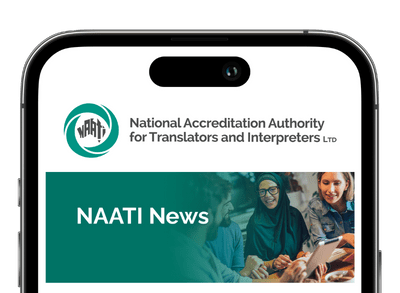All NAATI-certified translators and interpreters are provided a practitioner number (Certified Practitioner Number, or CPN), and a translator stamp or ID card (physical or digital) to verify their credentials and work. They will also receive a digital display certificate by email upon being awarded a credential or recertifying. Their practitioner number is 9 characters long, and will always start with “CPN”, followed by a number, 2 letters, 2 numbers and a letter (e.g. CPN7MF89K).
Stamps, ID cards and digital certificates are free with any credential or recertification.
Read below to understand the forms of ID you may see used by translators and interpreters, and how to verify the practitioner to ensure they have current NAATI credentials, or download a PDF summary of this page.
The former accreditation system
The NAATI Certification System commenced in January 2018 and succeeded the accreditation system that was in operation from 1977 – 2017. A range of improvements were introduced with the Certification System, including the requirement for all practitioners to demonstrate their continuing work practice and professional development by recertifying their credentials every three years. This means that a credential will expire after three years if the translator or interpreter chooses not to recertify. You can be assured that only practising professionals hold current NAATI credentials.
In the previous accreditation system, practitioners who were accredited prior to 2007 were awarded accreditation for life. People who held accreditations were able to transition their credentials across to certification for two years after the Certification System was launched; however, some people chose not to or did not because they were no longer practising.
This means that some people still hold active accreditations from this time. You may come across NAATI translator stamps or interpreter ID cards which have no expiry date. You will be able to identify practitioners who hold accreditation by their practitioner number which will only be numerical (e.g. 12453) in contrast to the CPN of certified practitioners which are comprised of a combination of letter and numbers.
Like a university degree these did not expire so are still valid, however NAATI recommends that you seek to engage only NAATI-certified translators or interpreters so you can ensure they have current and up-to-date skills and experience.
To verify an accreditation, you must email info@naati.com.au
Prior to the start of the Certification System in January 2018, NAATI issued translator stamps under the former accreditation system (see below for examples). These stamps are no longer issued however the translations containing these stamps remain valid indefinitely.

Verifying a practitioner
The homepage of NAATI’s website www.naati.com.au has a practitioner verification tool where you can enter the Practitioner Number of the translator or interpreter you wish to verify. This will show you the details of current or expired credentials held by that person.

NAATI digital stamps and ID cards
From March 2023, NAATI released digital identification options for certified practitioners. Practitioners can choose to use either a physical translator stamp or ID card, or the digital option. If you are presented a NAATI digital ID card or see a NAATI digital stamp on a translated document, it will contain a QR code which can be scanned to verify the credential. Read more on these below.
Webinar on digital stamps and ID cards
In the video below, Michael Nemarich, Manager of National Operations at NAATI discusses the new upgrades, including the digital stamps and ID cards, that NAATI has implemented to improve functionality, security, and ease of use for practitioners. This was a free online webinar hosted by AUSIT in March 2023.
Stamps
A NAATI translator stamp is used by translators to certify their translations. These stamps are issued to all translators upon receiving their certification and whenever they recertify.
Physical translator stamps
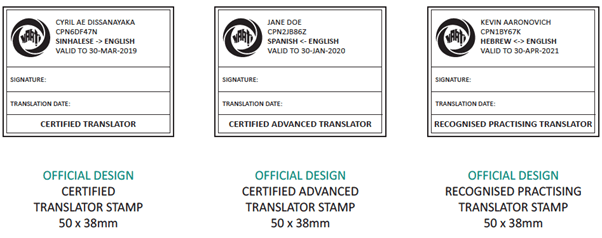
Once you have been awarded a credential or have been recertified, your new translator stamp and/or interpreter ID card will be produced and posted to you. You will receive your new products within 2-4 weeks if you are in Australia. Postage timeframes to overseas addresses will vary. Please make sure that your postal address listed in your myNAATI account is correct.
Above are examples of the current design of a NAATI-issued translator stamp. The ‘valid to’ date on these stamps refers to the recertification or potential expiry date of the practitioner’s credential (at the time the stamp was issued). It does not reflect a date after which a translation is invalid or unacceptable. A translation from a NAATI-credentialed translator should include the date at which the translation was completed and the translation remains valid indefinitely.
As translations do not expire, if the translation date listed on the stamp is within the period of validity for the credential (i.e. before the ‘valid to’ date), NAATI’s opinion is that the translation must be accepted where it has been presented (unless there are reasons other than the date for it not to be accepted).
You can also download this information on the official NAATI letterhead here which you may find useful to share with clients.
A NAATI certification or recognised practising credential can be verified through our Verify a Credential tool on the homepage of our website.
The expiry date on the translation stamp relates to the translator’s credential, not the validity of the translation.
Digital stamps
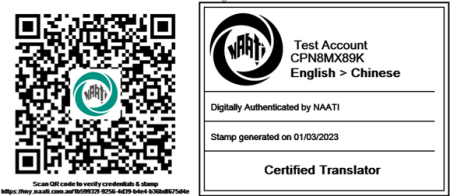
Practitioners can download your digital stamp from your myNAATI account.
- Log into myNAATI and ensure MFA is set up on your account. If you don’t wish to use an authenticator app for MFA you can also click the link “emailed to you” when prompted to have a secure code sent to your email that can be entered instead.
- Select ‘My Credentials’
- Download your digital stamp as a PNG file. You can paste this onto your digital translated documents.
Each digital stamp has a unique QR code that will enable clients to verify that person’s credentials. The QR codes are specific to the day it was generated, so practitioners should download a new stamp on the day they do their translation. The “Stamp generated on XX/XX/XXXX” details on the right-hand side replaces the “Translation date” found on the physical stamp. For the QR code to work it needs to be 2cm x 2cm if resized and “pasted” onto a document and for readability of the stamp in general we recommend 7cm wide as a minimum size.
If you are unable to scan the QR code, you can enter the unique 32-character identifier displayed below the QR code to the end of this link in a web browser: https://my.naati.com.au/VerifyPractitioner?QrCode=
Scanning the QR code or entering the 32-character identified after the link above will show you the details of current or expired credentials held by that person, and will clearly state if the digital stamp is valid. Where a practitioner has expired credentials but the stamp was generated when they were active, this will still state that the digital stamp is valid but you will see current credentials as expired.
In the case the QR code has been disabled for fraud or misuse, or it has been forged the returned information will say Digital Stamp: Invalid.
Each QR code on a stamp is unique, and NAATI can disable individual stamps in the case of fraud or misuse without impacting all other work the translator has done.
The digital stamp can only be downloaded by practitioners who sign into their myNAATI account using a password and a multi-factor authenticator code. The digital stamp does not include the credential expiry date. The QR code provides an additional level of security because the digital stamp cannot be generated unless the credential was active on that date.
Due to the 2-step process to download the stamp the signature panel in the digital stamp is replaced by “Digitally Authenticated by NAATI” and can be accepted without a physical signature.
There are 1,532,495,540,865,888,858,358,347,027,150,309,183,618,739,122,183,602,176 possible combinations of randomly generated code embedded in the stamp, making it impossible for someone to guess a valid number to create one.
Consumers can double-check the details returned with the practitioner and work that they’ve received to ensure credentials, name, and photo are consistent through this process.
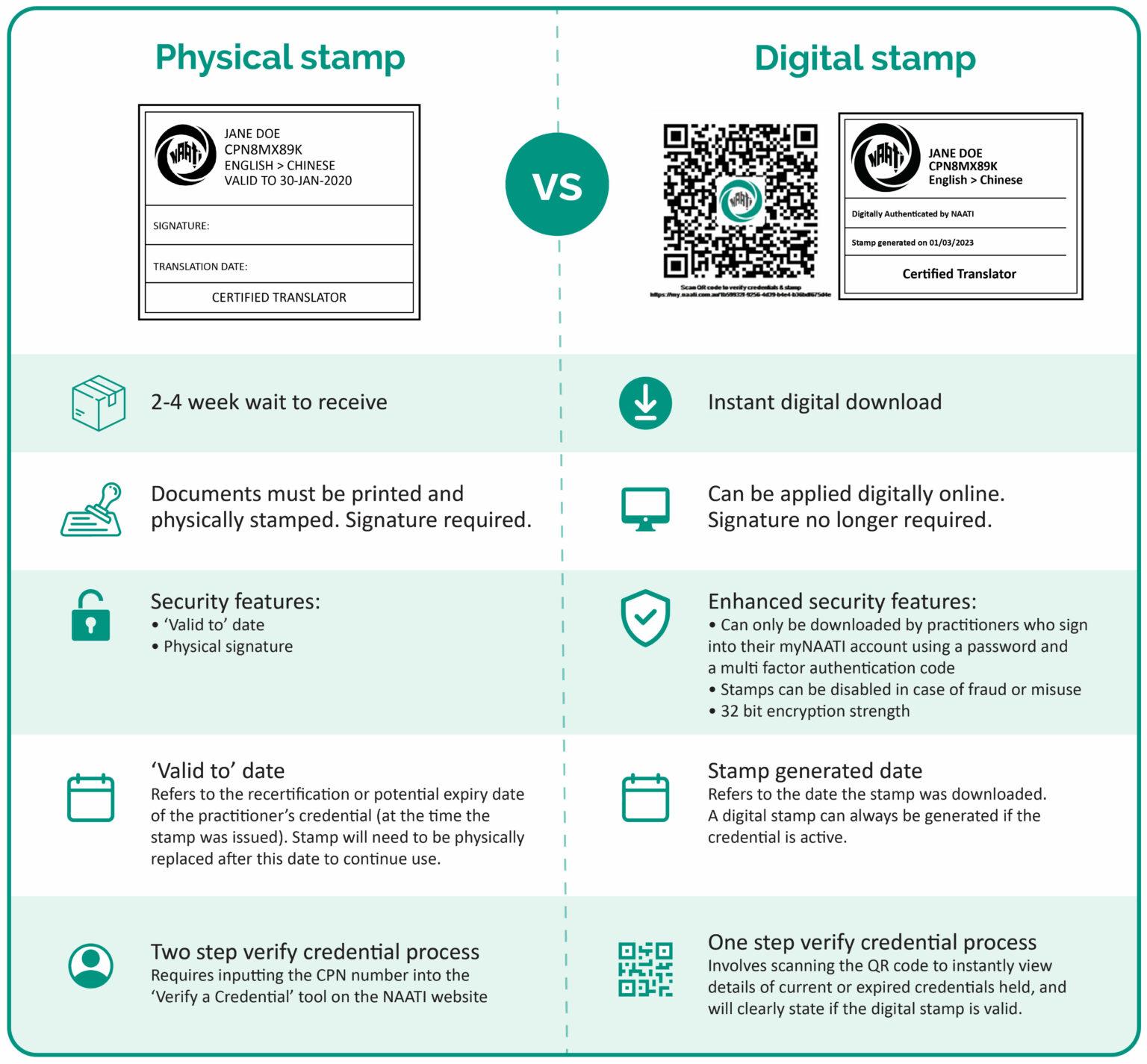
Id cards
Physical interpreter ID cards

NAATI interpreter ID cards are a standard bank card size and printed on a similar material. The card displays the practitioner’s photo, practitioner number and expiry on the front, with credentials and languages on the reverse. They are only issued to practitioners with an interpreter credential.
Once you have been awarded a credential or have been recertified, your new translator stamp and/or interpreter ID card will be produced and posted to you. You will receive your new products within 2-4 weeks if you are in Australia. Postage timeframes to overseas addresses will vary. Please make sure that your postal address listed in your myNAATI account is correct.
To verify them you will need to enter the practitioner number into NAATI’s verify a practitioner tool on the website.
Digital ID cards
Digital ID cards are available to all NAATI-certified practitioners who have current credentials and differ from physical cards in the inclusion of a scannable QR code with the second screen displaying existing credentials.
Due to the nature of the ID card it is unable to be saved to Google or Apple wallets, and practitioners will display it by either logging onto their myNAATI account at time of requirement or by saving a copy to their phone or device as a screen shot.
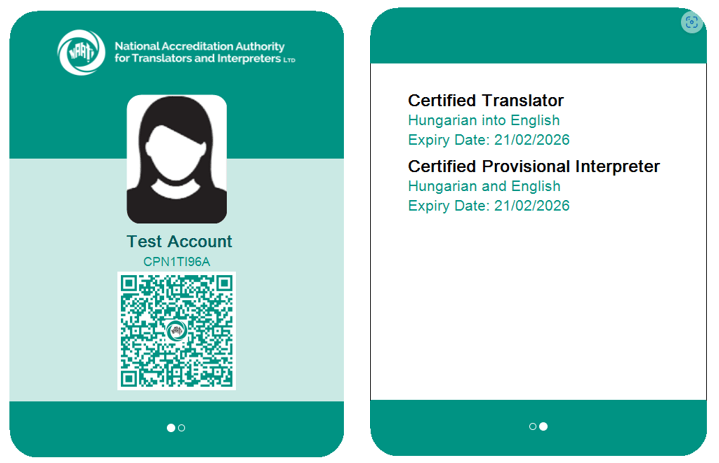
Practitioners can access their digital ID card from your myNAATI account.
- Log into myNAATI and ensure MFA is set up on your account. If you don’t wish to use an authenticator app for MFA you can also click the link “emailed to you” when prompted to have a secure code sent to your email that can be entered instead.
- Select ‘My Digital ID Card’
- Your card will be displayed on the screen. Clicking on the dots at the bottom of the card will move between your ID card and a list of your current credentials.
Each digital ID card has a unique QR code that will enable clients to verify that person’s credentials.
Scanning the QR code will show you the details of current or expired credentials held by that person and will clearly state if the digital ID card is valid.
In the case the QR code has been disabled for fraud or misuse, or it has been forged the returned information will say Digital Stamp: Invalid.
More questions?
Read some of the frequently asked questions here.


